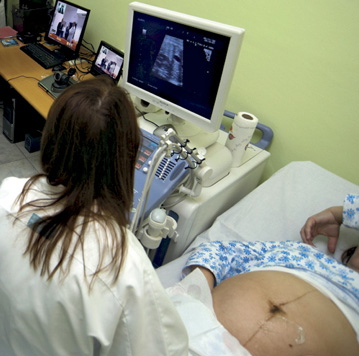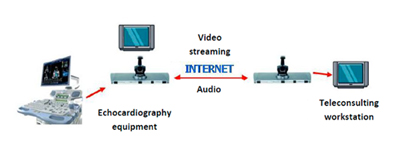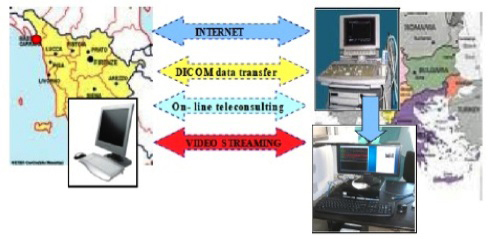I - Telemedicine
Technology has provided a foundation for telemedicine, breaking down geographical barriers to enable the delivery of specialised medical care virtually anywhere in the world. (1,2).
Telemedicine applies to diagnosis, consulting and transmission of medical data, signals, or images.
Tele-consulting usually involves the transmission of medical images over an on-line network, serving multi-centre, collaborative medical decision-making in diagnosis and care planning. Documents, whiteboards and computerised information can be shared. Hospitals interconnect through networks usable over the Internet, and health-care services as well as GPs’ offices can be linked to remote clinical centres that will an provide them with specialised assistance.
Systems are relatively easy to set up and DICOM, the standard in medical imaging systems, -digital imaging and communications in medicine- (3), has provided a framework for such data exchange. This open-source technology may actually be a valuable alternative to commercial systems, usually more costly.
Furthermore, videoconferencing allows people at remote sites to interact via two-way video and simultaneous audio transmissions. Seeing people face to face can be especially useful for diagnosis, consulting, with the added bonus of commenting of transmission of medical images in real-time.
Altogether, these devices are likely to promote collaborative health-care in various medical fields, including in countries not able to acquire expensive medical technology.
II - Limitations
Often sufficient, the store-and-forward, or otherwised called, asynchronous approach - when images or bio-signals are acquired from equipment and transmitted through a network later on- allows for off-line consultation/evaluation at remote health-care centres. However, for effective transmission through public networks and sensible data storage, compression techniques are inevitable especially given the fact that imaging studies tend to take up ever increasing data space. Core technology for adequate audio/video streaming is compression (up to 1:500). That being said, reaching desirable data reduction while preserving sufficient quality of images, to allow for a proper diagnosis, is a challenge. Powerful compression algorithms are available however measure of quality is dependent on subjective clinical decisions related to complex human knowledge models (4).
In most cases, collaborative evaluations of patients can be performed directly from outpatient physicians' offices, or peripheral health-care centres, in connection with reference centres, using the store-and-forward approach. Diagnostic examinations can be shared between various clinical teams allowing for collaborative medical decision-making in diagnosis and patient care planning.
When clinical conditions are critical on the other hand, hospitals themselves may lack the needed experience and specialists may be called upon for help. Such cases may require real-time (i.e. synchronous) transmission capability in view to limiting risks and avoiding added morbidity and costs.
Particularly with this solution, one must prepare for the occasional limited bandwidth and/or, instability or discontinuity of internet connections. The store-and-forward solution for these instances, is good to have as back-up.
III - Our project
Our project was developed at the G. Pasquinucci Heart Hospital of “G. Monasterio” CNR/Tuscany region Foundation in Massa with the financial support of both “Un Cuore un Mondo” Association and the same Tuscany Region in Italy. Our goal was to set up a cooperative network with clinical centres in Western Balkan Countries, Croatia, Bosnia & Herzegovina, Albania, Kosovo and Montenegro for the diagnosis and care of congenital heart malformations.
For early detection and optimal care planning (6), great attention is dedicated to the foetus at the Heart Hospital, in addition to neonate or infant patients. Inadequate local experience in diagnosis and care of congenital heart abnormalities required collaboration from experts at the Heart Hospital reference centre in Massa. Experts in Massa remotely assisted the operator in remote centres of these countries to drive scanning during imaging examination, in order to reach an expert-enlightened joint echocardiography diagnosis.
For this to work, a tele-consulting network connecting clinical centres in the Balkan Area with the cardiac department of the Heart Hospital in Massa, Italy was set up by Internet. Tele-echocardiography was implemented at Paediatric Clinical Centres of both Banja Luka in Bosnia and Herzegovina, and Rijeka in Croatia, and later on at a Gynaecology Hospital in Tirana, in Albania. Further workstations were installed at other Bosnia and Herzegovina clinical centres in Tuzla, Sarajevo and Mostar.
During tele-consulting sessions, the very young patients suffering cardiac disease, were studied by echocardiography jointly by physicians at the given remote site and at the Heart Hospital in Massa. Foetal echocardiography was also performed to allow for early care planning before delivery (Fig 1).
Live tele-consulting was crucial for two reasons. It helped 1) to plan timely care or intervention of patients and also 2) to interact with the remote echo-cardiograph operator for proper scanning of heart anatomy, especially in the foetus or neonate. At times, limitations of public network bandwidth (the Internet), or instability of it, affected quality of diagnostic images and the degradation was high enough to render detection of cardiac abnormalities difficult. In these situations store-and-forward tele-consulting was suggested to transfer imaging records thus preserving full diagnostic information.
Commercial videoconference equipment (Aethra Vega X3 or X5) were initially applied for transmitting sequences of echocardiographic images over the Internet. Multipoint Control Units allow videoconferencing among a greater number of locations.
One videoconferencing installation was installed in the echocardiography room at the remote Hospital and the other one at the reference Hospital, connected through the Internet. Plugging the analogue video output from the echo-cardiographer into the videoconference equipment was straight-forward (Fig 2).
Upload data transfer rate greater than 512 kbps was provided to ensure a minimal required level of quality to allow for diagnostic accuracy of echo images transmitted in real time from the echocardiographer. Local network firewall settings had to be adjusted with the system administrator. Cryptography was applied for data protection. In case of limited bandwidth, instability or discontinuity of Internet connections, the http://www.ubuntu.com store-and-forward solution could be applied. For functionality, scalability and cost-effectiveness purposes, open-source technology was used and low-cost devices enabling both live and store-and-forward tele-consulting as well as videoconferencing and image storage/management were set up. (5)
III - Open-Source
We implemented the prototype of tele-consulting device, embedding open-source software on small-size standard hardware under Linux http://www.ubuntu.com (6). The web site “http://award.altervista.org” (telemedicine free project) (7) was the reference we used for both software and hardware components we applied. The basic functions were: analogue video signal acquisition and digitisation from imaging equipment; digital compression; encrypted streaming of images (DICOM and not) through the Internet http://www.videolan.org/vlc videoconferencing capability for on-line operator interaction http://ekiga.org DICOM server utility http://www.dcm4che.org for storage, management and distribution of image studies (PACS capability).
At the diagnostic centre the operator, using the tele-consulting workstation, can choose by local graphical user interface (GUI) among the following functions:
- LIVE: for transferring by streaming the video signal acquired from analogue output of echo-cardiographer in real time.
- DICOM: for managing and distributing image studies achieved by DICOM sources (echo-cardiographer or other modality diagnostic equipment).
- ARCHIVE: for recording video signal from echo-cardiographer into standard file.
- At the receiving side (i.e. at the cardiac department in Massa) by means of Internet web browser, diagnostic images are reproduced on computer monitor, invoking video streaming (LIVE or ARCHIVE) or retrieving DICOM records.(Figure 3)
The cost for a videoconference workstation, as we have installed in Balkan Countries, was from 3000 Euro up. The hardware cost (for open-source teleconsulting workstation computer, acquisition card, web cam) was roughly 500 Euro.
Of course, costs for technicians helping to set up the system need to be added to the project however internet connection (upload > 512 Kbps), is often already available in a health care setting.
Last but not least, agreements for clinical responsibility of teleconsulting were needed.
Fig 1: Tele-echocardiography on foetus from Gynaecology Hospital in Tirana.

Fig 2: Use of videoconference equipment in tele-echocardiography.

Fig 3: Teleconsulting: diagnostic images transferred via Internet - on-line or off-line -from Balkan centers to the cardiac department in Massa for collaborative diagnosis.

Conclusion:
Videoconferencing equipment, available in a variety of models (8), allows for easy implementation of tele-consulting through the Internet - provided an adequate connection is available. Our report of tele-echocardiography in cooperation with clinical centres of Balkan Countries for diagnosis and care planning of congenital heart diseases is complemented by other experiences in collaborative medical decision-making reported in cardiology (9) and have also been applied to other medical fields.
While commercial systems are limited in terms of functionality, versatility, scalability and cost-effectiveness, new solutions, using open-source technology, provide us the challenge to spread tele-consulting to provide specialised care virtually anywhere there is Internet. However, telemedicine projects often fail to grow beyond the pilot phase of implementation, because other than the usual barriers, namely, reimbursement and legislation, user acceptance of telemedicine technologies is essential (10). Actually user-centred design is crucial in the development of telemedicine systems in clinical practice.


 Our mission: To reduce the burden of cardiovascular disease.
Our mission: To reduce the burden of cardiovascular disease.